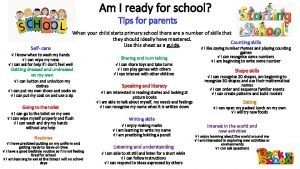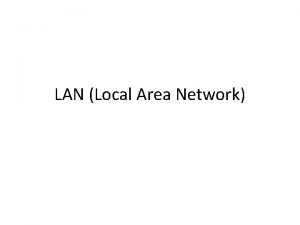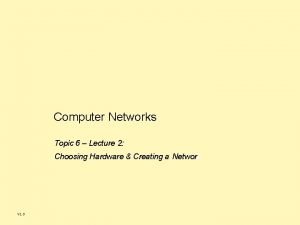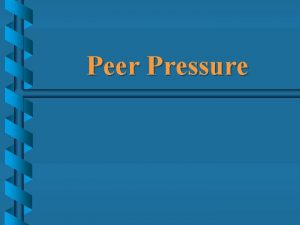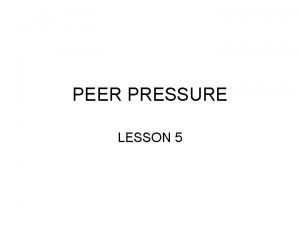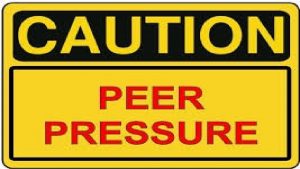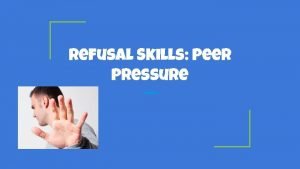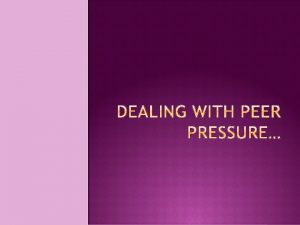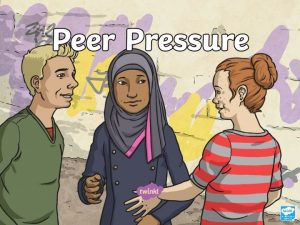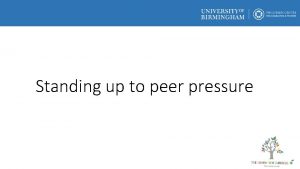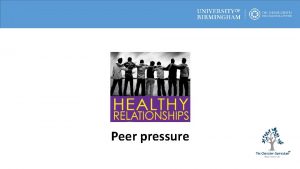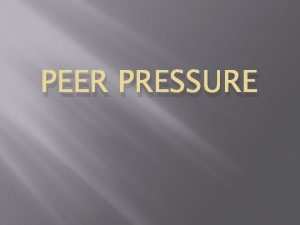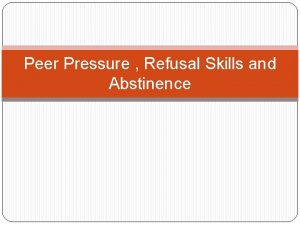Peer pressure Contents Peer Pressure Tips for Parents













- Slides: 13

* Peer pressure

Contents Peer Pressure Tips for Parents Positive vs. Negative Peer Pressure How to identify a troubled adolescent › Warning signs Strategies to Help Children › Skill building activities Communication How to Say No

Pressure Peer Pressure is a normal part of life and adolescent need guidance from their parents and other adults so that they are able to handle these pressures in a positive way. Transition into high school and becoming a teenager can be very challenging for adolescent. Some changes include pressures from friends and peers. Some of these pressures may be drugs, truancy, sex, shop-lifting, bullying, cheating, and any other action that a child may not want to do.

Positive vs. Negative Peer Pressure- Positive Peer Pressure- Skipping school Vandalizing Smoking Sneaking out of the house • Bullying • Disrespecting authority • Sex • • • Is often dangerous and against school rules, home rules and personal values. • • Is often overlooked but does exist and may be described as an influence to do what is right. Studying Volunteering Befriending someone Community Service Joining a sports team

What you can do? Make teens aware of some of the pressures they may encounter Demonstrate the difference between positive and negative peer pressure Provide suggestions and strategies to help children deal with peer pressure

How to identify a troubled adolescent Traits that put students at a higher risk of falling to peer pressure Low self esteem Lack of confidence Uncertainty about ones place within a given peer group No personal interests exclusive of one's peer group Feeling isolated from peers and/or family Lack of direction in life Depression Eating disorders Poor academic abilities or performance http: //teenadvice. about. com/cs/peerpressure/a/blpeerpressure. htm

Helping Children Deal with Peer Pressure Steps children can follow when confronted with peer pressure: Ask Questions “Why would we do that ? ”, “Whose idea was this ? ”, “Is this a smart thing to do ? ” Identify the negative behavior or action › “Calling her names is just going to start trouble”, “ don’t think smoking is a good idea”, “It is against school policy to leave the grounds”. Evaluate the consequences › “We will get in trouble”, “Smoking is not healthy”, “My parents will take away my allowance” http: //www. new-life. net/parent 06. htm

Steps continued: Suggest an alternative › “Why don’t we go to the store after school is over” Leave the situation › If all else fails, remove yourself from the situation. Walk away and do something else http: //www. new-life. net/parent 06. htm

Positive and Healthy Ways to Deal with Pressures Strategies for teens to use: • Make a joke and change the subject • Say “no” and keep saying “no” • Leave the area • Get help from someone you trust • Suggest a different activity • Hang out with others who share your beliefs Help students develop decision making skills

Strategies to help adolescent deal 1. Relinquish the stereotype of peers as a uniformly negative influence on youth. 2. Nurture teenagers' abilities and self-esteem so they can forge positive peer relationships 3. Empower parents and educators to help teenagers pursue and maintain positive peer relationships 4. Encourage cross-ethnic and "cross-class" peer interactions and guide teenagers in dealing positively with cultural diversity and individual differences.

Strategies to help children deal 5. Place sensible restraints on part-time teen employment 6. Support parent education programs for families with teenagers 7. Establish intervention programs for preadolescents with low social skills or aggressive tendencies. http: //sitemaker. umich. edu/356. darnell/strategies_for_coping_with_peer_pressure

Resources Continued • How to Say No and Keep your Friends: Peer Pressure Reversal for Teens and Pre-Teens (1997). By Sharon Scott

Resources Continued Resource for parents: http: //sitemaker. umich. edu/356. darnell/advice_for_parents
 I am ready to school
I am ready to school Parents parents
Parents parents Frida kahlo famille arbre généalogique
Frida kahlo famille arbre généalogique Famille de frida kahlo arbre généalogique
Famille de frida kahlo arbre généalogique Jaringan peer to peer diistilahkan dengan
Jaringan peer to peer diistilahkan dengan Esempio registro peer to peer compilato
Esempio registro peer to peer compilato Peer to peer computing environment
Peer to peer computing environment Peer to peer merupakan jenis jaringan… *
Peer to peer merupakan jenis jaringan… * Peer to peer network hardware
Peer to peer network hardware Tim beamer
Tim beamer Peer to p
Peer to p Esempi di peer to peer compilati
Esempi di peer to peer compilati Peer to peer intervention
Peer to peer intervention Features of peer to peer network and client server network
Features of peer to peer network and client server network
